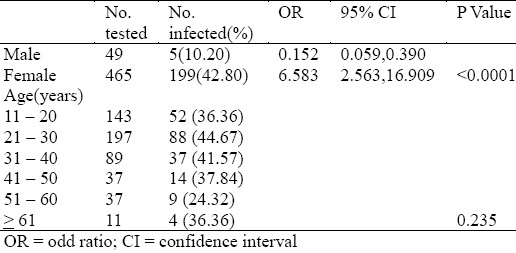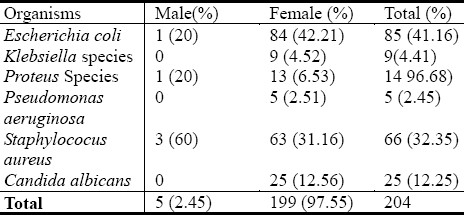Abstract
Aim:
To determine the prevalence of urinary tract infection (UTI) in Okada, a rural community in Nigeria, and the effect of age and gender on its prevalence as well as the etiologic agents and the susceptibility profile of the bacterial agents.
Patients and Method:
Clean-catch midstream urine was collected from 514 patients (49 males and 465 females). The urine samples were processed and microbial isolates identified. Susceptibility testing was performed on all bacterial isolates.
Result:
The prevalence of urinary tract infection was significantly higher in females compared to males (female vs. male: 42.80% vs. 10.20%; OR = 6.583. 95% CI = 2.563,16.909; P < 0.0001). Age had no effect on the prevalence of UTI. Escherichia coli was the most prevalent isolate generally and in females, while Staphylococcus aureus was the predominant isolate causing urinary tract infection in males. The flouroquinnolones were the most active antibacterial agents.
Conclusion:
An overall prevalence of 39.69% was observed in this study. Females had a 3 to 17 fold increase risk of acquiring UTI, than their male counterpart. Escherichia coli were the predominant isolates causing UTI.
Keywords: Urinary tract infection, rural community, prevalence, bacterial, Escherichia coli, Staphylococcus aureus
Introduction
Urinary tract infections are among the most common bacterial infections in humans both in the community and hospital settings, and they occur in all age groups, and usually required urgent treatment[1]. Urinary tract infection remains a leading cause of healthcare expenditure for people of all age groups, with an overall annual cost of 1.6 billion dollars in the United States of America[2].
Malnutrition, poor hygiene, low socio-economic status are associated with urinary tract infections and these factors are rife in rural settings[3]. Although Escherichia coli has been reported as the predominant isolate causing urinary tract infection, few authors have reported changing patterns in the prevalence of uropathogens[4,5]. Urinary pathogens especially from community patients have been known to include strains that are resistant to many of the commonly used antibiotics[6]. Therefore there is need for periodic monitoring of etiologic agents of urinary tract infection, and their susceptibility pattern especially in a rural setting. Against this background, as well as the paucity of reports of urinary tract infections in our rural community (Okada), this study was undertaken.
The aim of this study is to determine the prevalence of urinary tract infection in Okada community as well as the effect of gender and age on its prevalence. The etiologic agents and their susceptibility pattern will also be determined.
Patients and Methods
Study area
Okada, a rural community, is the headquarters of Ovia North East Local Government Area of Edo-state. The Local Government has on estimated population of 155 344 persons[7]. Majority of the residents of Okada are farmers with few Civil Servants, Lecturers and Students making less than 5% of the community. The study was carried out at Igbinedion University Teaching Hospital, Okada from January 2007 to December 2009. Some neghbouring rural communities (villages) also attend the Hospital.
Study population
A total of five hundred and fourteen patients with signs and symptoms of urinary tract infection were recruited for this study. They consisted of 465 females, and 49 males, with age ranging from 12 to 76 years. Exclusion criteria included antibiotic usage within week and large fluid intake (less than one hour) before clinic attendance. Verbal informed consent was obtained from all patients or their parents in case of children prior to specimen collection. The Ethical Committee of Igbinedion University Teaching Hospital, Okada approved the protocol for this study.
Specimen collection and processing
Clean–catch midstream urine was collected from each patient into sterile screw–capped universal container, containing, few crystals of boric acid as preservative. The specimen was mixed, labeled and transported to the laboratory for processing.
A loopful (0.001mL) of well mixed un-centrifuged urine was streaked on to the surface of blood agar and cysteine lactose electrolyte deficient (CLED) medium. (M6: Plasmatec Laboratories, United Kingdom). The plates were incubated aerobically at 37°C for 24hrs and counts were expressed as colony forming units (cfu) per milliliter (mL). A count of ≥ 105 cfu/ml was considered significant to indicate UTI
Ten ml of each well–mixed urine sample was centrifuged at 2000g for 5 minutes. The supernatant was discarded and a drop of the deposit was examined microscopically at high magnification for pus cells red blood cells, epithelial cells, cast, crystal, yeast-like cells and Trichomonas vaginalis. Pus cells ≥ 5 per high power field were considered significant to indicate infection. Urinary tract infection was diagnosed, if the bacteria or pus cell count, or both were significant in an individual. The isolates were identified by standard microbiological method[8], and disc susceptibility test for bacterial isolates was performed by BSAC method[9].
Statistical analysis
The data were analyzed using Chi square (X2) test and odd ratio analysis, using the statistical software INSTAT(R).
Results
A total of 204 (39.69%) out of 514 patients had urinary tract infection. Female gender was a significant risk factor for acquiring UTI (female vs. male: 42.8% vs. 10.2%, OR = 6.583, 95% CI = 2.563, 16.909%, P < 0.0001, Table 1). The prevalence of UTI was highest within the 21 – 30years age group (44.67%), and was least within the age range of 51 – 60 years (24.32%), although age did not significantly affect the prevalence of UTI (P=0.253).
Table 1.
Effect of gender and age on prevalence of urinary tract infection

Escherichia coli were the most predominant isolate causing UTI, as well as in females (Table 2). This is followed by Staphylococcus aureus, Candida albican, and Pseudomonas aeruginosa was the least with a prevalence of 2.45%. Staphylococcus aureus was the most predominant isolate causing UTI in male. Klebsiella species, Pseudomonas aeruginosa, and Candida albicans were not recovered from male patients. The susceptibility profile of the bacterial isolates showed that ciprofloxacin was the most active antibacterial agent, while nalidixic acid, nitrofurantoin, sulphamethoxazole–trimetoprim, amoxicillin and amoxicillin–clavulanate and were poorly active against the bacterial isolates (Table 3).
Table 2.
Prevalence of uropathogens

Table 3.
Susceptibility profiles of urinary bacterial isolates

Discussion
Against the background of paucity of reports of urinary tract infection in our rural setting, this study aimed at determining the prevalence of UTI, in a rural community (Okada), the effect of gender and age on its prevalence, as well as the etiologic agents and their susceptibility profile.
A total of 204 (39.69%) out of the 514 patients had UTI. This is lower than the 49% obtained by Orrett[6]. Geographical location may be the reason for the difference. The finding that females had higher prevalence of UTI than males agrees with earlier studies[5,10,11]. Close proximity of the female urethral meatus to the anus, shorter urethra, and sexual intercourse have been reported as factors that influences this higher prevalence in women[4].
The age range of 21 – 30 years had the highest prevalence of UTI (44.67%). This is in agreement with the findings of Orrett[6]. However the prevalence of UTI did not differ significantly within age groups in this study.
Escherichia coli were the predominant isolate causing UTI in this study. This agrees with previous reports[6,11,12]. However two recent studies in Benin City (urban settlement), Nigeria indicate Staphylococcus aureus as the predominant isolate[4,5]. These studies were on asymptomatic subjects as compared to this current study which was on persons with symptoms of UTI. It is possible that the agents of symptomatic and asymptomatic UTI differ. However, this will require further investigations to verify.
The reason for the high prevalence of Staphylococcus aureus in males is not clear, though lack of circumcision receptive anal intercourse and HIV infection are recognized risk factors for UTI in males[1]. The susceptibility profile indicates that the flouroquinolones were the most active antibacterial agents followed by the aminoglycosides. This result is in agreement with recommendations of Stamm and Hooton[13]. Nalidixic acid, nitrofurantoin, sulphamethoxazole–trimetoprim, amoxicillin and amoxicillin–clavulanate showed very poor activity. This may be due to long term use of these drugs over the years. Also, prescription of antibiotics without laboratory guidance as well as over the counter sales of antibiotics without prescription are rife in the Nigerian setting[5,14].
Conclusively, an overall prevalence of 39.69% of UTI was observed in this study. Females had a 3 – 17 fold increase risk of having UTI, and Escherichia coli was the predominant isolate causing UTI. Although the flouroquinolones were the most active antibacterial agents, prudent use of antibiotics is advocated.
References
- 1.Orrett FA, Davis GK. A comparison of the antimicrobial susceptibility profile of urinary pathogens for the years 1999 and 2003. West Indian Med J. 2006;55:95–99. doi: 10.1590/s0043-31442006000200006. [DOI] [PubMed] [Google Scholar]
- 2.Vasquez V, Hand WL. Antibiotic susceptibility patterns of community–acquired urinary tract infection isolates from female patients on the US (Texas)–Mexico border. J Appl Res. 2004;4(2):321–326. [Google Scholar]
- 3.Ahmed SM, Avasara AK. Urinary tract infections (UTI) among adolescent girls in rural Karimnagar District, AP K.A.P. STUDY. Indian J Pre Soc Med. 2008;39(1 & 2) [Google Scholar]
- 4.Omoregie R, Erebor JO, Ahonkhai I, Isobor JO, Ogefere HO. Observed changes in the prevalence of uropathogens in Benin City, Nigeria. NZJ Med Lab Sci. 2008;62:29–31. [Google Scholar]
- 5.Omoregie R, Eghafona NO. Urinary tract infection among asymptomatic HIV patients in Benin City, Nigeria. Br J Biomed Sci. 2009;66(4):190–193. doi: 10.1080/09674845.2009.11730272. [DOI] [PubMed] [Google Scholar]
- 6.Orrett FA. Urinary tract infection in general practice in a rural community in south Trinidad. Saudi Med J. 2001;22(6):537–540. [PubMed] [Google Scholar]
- 7.National Population Commission. Population and Housing Census of the Federal Republic of Nigeria. 2006 [Google Scholar]
- 8.Barrow GI, Feltham RKA. Cowan and Steel's manual for the identification of medical bacteria. 3rd edition. Cambridge: Cambridge University Press; 2003. [Google Scholar]
- 9.British Society for Antimicrobial Chemotherapy (BSAC) BSAC methods for Antimicrobial susceptibility testing. Version 8. 2009 [Google Scholar]
- 10.Anochie JC, Nkanginieme KEO, Eke FU. The influence of instruction about the method of urine collections and storage on the prevalence of urinary tract infection. Niger J Paediatr. 2001;28:39–42. [Google Scholar]
- 11.Aiyegoro OA, Igbinosa OO, Ogunmwonyi IN, Odjadjaro E, Igbinosa OE, Okoh AI. Incidence of urinary tract infections (UTI) among children and adolescents in Ile – lfe, Nigeria. Afr J Microbiol Res. 2007;1:13–19. [Google Scholar]
- 12.Drew SJ, Poutanen SM, Mazzulli T, et al. Decreased prevalence of virulence factors among ciprofloxacin resistant uropathogenic Escherichia coli isolates. J Clin Microbiol. 2005;43:4218–4220. doi: 10.1128/JCM.43.8.4218-4220.2005. [DOI] [PMC free article] [PubMed] [Google Scholar]
- 13.Stamm WE, Hooton TM. Management of urinary tract infection in adults. New Engl J Med. 1993;329:1328–1334. doi: 10.1056/NEJM199310283291808. [DOI] [PubMed] [Google Scholar]
- 14.Okeke IN, Lamikanra A, Edelman R. Socio–economic and behavioural factors leading to acquired bacterial resitance to antibiotics in developing countries. Emerg Infect Dis. 1999;5(1):18–27. doi: 10.3201/eid0501.990103. [DOI] [PMC free article] [PubMed] [Google Scholar]


